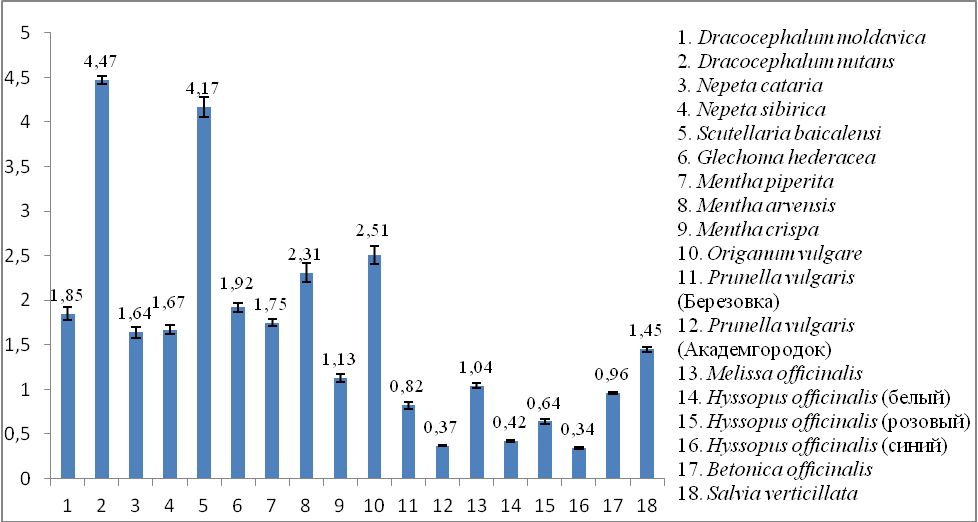ANTI-INFLUENZA ACTIVITY OF PLANT EXTRACTS OF THE LAMIACEAE FAMILY
UDC 578.832; 582.929.4; 615.281
Abstract
In this work, it was revealed that water and ethanol extracts of the plants Nepeta cataria, Nepeta sibirica, Scutellaria baicalensis, Hyssopus officinalis, Betonica officinalis, and water extracts of Dracocephalum moldavica, Glechoma hederacea, Mentha arvensis, Prunella vulgaris, Melissa officinalis ethanol extracts of Mentha piperita, Mentha crispa, Origanum vulgare, Hyssopus officinalis, Salvia verticillata showed antiviral activity against the influenza virus subtype H5N1. Aqueous extracts of Nepeta cataria and Glechoma hederacea (NI 3.75) showed the highest antiviral effect against the H5N1 subtype.
It was revealed the antiviral activity against influenza virus subtype H3N2 of aqueous and ethanol extracts of Scutellaria baicalensis, Mentha piperita, Mentha arvensis, Mentha crispa, aqueous extract of Dracocephalum moldavica and ethanol extracts of Glechoma hederacea, Origanum vulgare, Prunella vulgaris, Hyssopus officinalis, Betonica officinalis, Salvia verticillata. Ethanolic extract of Betonica officinalis (NI 4.25) showed the highest virus neutralizing activity against the H3N2 subtype.
It was carried out chemical analysis of the aerial parts of plants of the Lamiaceae family. It was shown that the highest content of flavonols was observed in Dracocephalum nutans (4.47±0.04%), the highest content of tannins was found in Mentha arvensis (17.62 ± 0.78%), and the highest content catechins were found in Nepeta cataria (0.43 ± 0.007%).
Thus, plant extracts of the Lamiaceae family are promising sources for further studies to develop new antiviral drugs.
Downloads
Metrics
References
Vsemirnaya organizatsiya zdravookhraneniya: informatsionnyy byulleten' po grippu, mart 2018. [World Health Or-ganization: Influenza Fact Sheet, March 2018]. URL: https://www.who.int/ru/news-room/fact-sheets/detail/influenza-%28seasonal%29. (in Russ.).
Yershov F.I., Romantsev M.G. Lekarstvennyye sredstva, primenyayemyye pri virusnykh zabolevaniyakh. [Medicines used for viral diseases]. Moscow, 2007, 368 p. (in Russ.).
Li K.S., Guan Y., Wang J., Smith G.J.D., Xu K.M., Duan L., Rahardjo A.P., Puthavathana P., Buranathai C., Nguyen T.D., Estoepangestle A.T.S., Chaisingh A., Auewarakul P., Long H.T., Hanh N.T.H., Webby R.J, Poon L.L.M, Chen H., Shortridge K.F., Yuen K.Y., Webster R.G., Peiris J.S.M. Nature, 2004, vol. 430, no. 6996, pp. 209–213. DOI: 10.1038/nature02746.
Watts J. Lancet, 2004, vol. 363, no. 9406, p. 373. DOI: 10.1016/S0140-6736(04)15475-5.
Abad M.J., Guerra J.A., Bermejo P., Irurzun A., Carrasco L. Phytother Res., 2000, vol. 14, no. 8, pp. 604–607. DOI: 10.1002/1099-1573(200012)14:8<604::aid-ptr678>3.0.co;2-l.
Singh P., Chakraborty P., He D.H., Mergia A. Acta Virol., 2019, vol. 63, no. 3, pp. 316–321. DOI: 10.4149/av_2019_307.
Tan Y.P., Houston .SD., Modhiran N., Savchenko A.I., Boyle G.M., Young P.R., Watterson D., Williams C.M. Chemistry, 2019, vol. 25, no. 22, pp. 5664–5667. DOI: 10.1002/chem.201900591.
Li Y., Liu Y., Ma A., Bao Y., Wang M., Sun Z. Food Sci. Biotechnol., 2017, vol. 26, no. 6, pp. 1675–1683. DOI: 10.1007/s10068-017-0217-9.
Yin Z.K., Feng Z.M., Jiang J.S., Zhang X., Zhang P.C., Yang Y.N. J. Asian Nat. Prod. Res., 2020, vol. 22, no. 1, pp. 24–29. DOI: 10.1080/10286020.2019.1645132.
Zhang D., Guo J., Zhang M., Liu X., Ba M., Tao X., Yu L., Guo Y., Dai J. J. Nat. Prod., 2017, vol. 80, no. 12, pp. 3241–3246. DOI: 10.1021/acs.jnatprod.7b00659.
Rastitel'nyye resursy Rossii: Dikorastushchiye tsvetkovyye rasteniya, ikh komponentnyy sostav i biologicheskaya aktivnost'. T. 4. Semeystva Caprifoliaceae – Lobeliaceae. [Plant resources of Russia: Wild flowering plants, their com-ponent composition and biological activity. Vol. 4. Families Caprifoliaceae - Lobeliaceae]. St.-Petersburg; Moscow, 2011, 630 p. (in Russ.).
Astani A., Reichling J.,Schnitzler P. Chemotherapy, 2012, vol. 58, no. 1, pp. 70–77. DOI: 10.1159/000335590.
Li R., Wang L. Mol. Med. Rep., 2019, vol. 20, no. 6, pp. 5041–5049. DOI: 10.3892/mmr.2019.10743.
Protsenko M.A. Razrabotka tekhnologii eksperimental'nykh obraztsov preparatov iz vysshikh bazidiomitsetov: dis. ... kand. biol. nauk. [Development of technology for experimental samples of drugs from higher basidiomycetes: dis. ... Cand. biol. sciences]. Kol'tsovo, 2016, 178 p. (in Russ.).
Belikov V.V., Shrayber M.S. Farmatsiya, 1970, no. 1, pp. 66–72. (in Russ.).
Kukushkina T.A., Zykov A.A., Obukhova L.A. Aktual'nyye problemy sozdaniya novykh lekarstvennykh preparatov prirodnogo proiskhozhdeniya: materialy VII Mezhdunarodnogo S"yezda. [Actual problems of creating new medicines of natural origin: materials of the VII International Congress]. St.-Petersburg, 2003, pp. 64–69. (in Russ.).
Fedoseyeva L.M. Khimiya rastitel'nogo syr'ya, 2005, no. 2, pp. 45–50. (in Russ.).
Zaks L. Statisticheskoye otsenivaniye. [Statistical estimation]. Moscow, 1976, 598 p. (in Russ.).
Khalafyan A.A. Statistica 6. Statisticheskiy analiz dannykh. 2-ye izd. [Statistica 6. Statistical data analysis. 2nd ed.]. Moscow, 2010, 528 p. (in Russ.).
Khabriyev R.U. Rukovodstvo po eksperimental'nomu (doklinicheskomu) izucheniyu novykh farmakologicheskikh vesh-chestv: spravochnik. 2-ye izd., pererab. i dop. [Guidelines for experimental (preclinical) study of new pharmacological substances: a handbook. 2nd ed., Rev. and add.]. Moscow, 2005, 832 p. (in Russ.).

Copyright (c) 2021 chemistry of plant raw material

This work is licensed under a Creative Commons Attribution 4.0 International License.

This work is licensed under a Creative Commons Attribution 4.0 International License.
The authors, which are published in this journal, agree to the following conditions:
1. Authors retain the copyright to the work and transfer to the journal the right of the first publication along with the work, at the same time licensing it under the terms of the Creative Commons Attribution License, which allows others to distribute this work with the obligatory indication of the authorship of this work and a link to the original publication in this journal .
2. The authors retain the right to enter into separate, additional contractual agreements for the non-exclusive distribution of the version of the work published by this journal (for example, to place it in the university depository or to publish it in a book), with reference to the original publication in this journal.
3. Authors are allowed to post their work on the Internet (for example, in a university repository or on their personal website) before and during the review process of this journal, as this may lead to a productive discussion, as well as more links to this published work.











